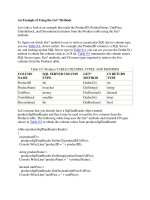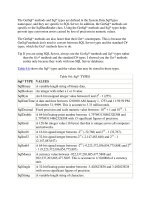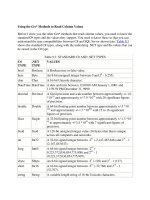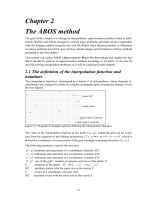The GrammarTranslation Method
Bạn đang xem bản rút gọn của tài liệu. Xem và tải ngay bản đầy đủ của tài liệu tại đây (38.53 KB, 4 trang )
<span class='text_page_counter'>(1)</span><div class='page_container' data-page=1>
1
Grammar-Translation Method
Contents:
Background
Principal Features & Theoretical Assumptions
Objectives, Syllabus, Teacher & Learner Roles
Key Features
Typical Techniques
Criticisms & Comments
References
2
Background
Faculty Psychology, a core concept of education in Europe in 18-19th centuries:
body & mind were separate; the mind consisted of three parts or faculties: the will,
emotion, & intellect.
the intellect could be sharpened enough to eventually control the will and emotion.
The way to do this was through learning classical literature of the Greeks and
Romans, as well as mathematics.
As a result, textbooks were essentially copied for the language classroom & GTM,
or the Prussian Method as known in US, (Richards & Rogers 1986: 3) predominated
in language teaching from the mid 1840s to the mid 1940s
The Traditional Grammar lays emphasis on correctness, literary excellence, the use
of Latin models, and the priority (uu tien) of the written language.
The text books take prominent (loi lac) writers as language models. They
concentrate on detailed points and favor the formality of language.
3
Principal Features & Theoretical Assumptions
Principal Features: emphasizes the teaching of the second language grammar; its
principal practice technique is translation from and into the target language.
Theoretical Assumptions:
L2 primarily viewed as a system of rules to be observed in texts and sentences & to
be related to first language rules and meanings.
Language learning regarded as intellectual activity which provides students with
good mental exercises to develop their minds. It consists of little more than
memorizing rules and facts by means of massive translation practice in order to
understand and manipulate the morphology and syntax of the second language.
L1 is maintained as the reference system in the acquisition of L2.
4
Objectives, Syllabus, Roles
</div>
<span class='text_page_counter'>(2)</span><div class='page_container' data-page=2>
attention paid to speaking or listening.
Syllabus: based on grammar & vocabulary. Grammar rules presented, illustrated &
practiced through translation exercises. Vocabulary selection based solely on the
reading texts used and a list of vocabulary items are presented with their L1
equivalents.
Learner & Teacher Roles: Wholly teacher-centered. The teacher is the authority of
the classroom. Learners viewed as passive receivers of knowledge. They can learn
only what the teacher knows.
Roles of First Language: L1 is the medium of instruction; used to explain new items
and to enable comparisons to be made between the foreign language and the
learner’s first language.
5
Key Features
L2 learning seen as an intellectual activity: deductive (pp dien dich) explanations of
intricate grammar given and then practised through translation exercises
Strong emphasis on accuracy and form, fluency & meaning neglected
little interaction between the learners and the teacher; almost no interaction between
students
Much vocabulary is taught in the form of lists of isolated words.
Grammar provides the rules for putting words together, and instruction often focuses
on the form and inflection of words.
Reading of difficult classical literary texts right in early stages.
Common drills include exercises in translating disconnected sentences from L2 into
L1.
Little or no attention is given to pronunciation.
6
Typical Techniques
Translation of a Literary Passage (Translating target language to native language)
Reading Comprehension Questions (Finding information in a passage, making
inferences and relating to personal experience)
Antonyms/Synonyms (Finding antonyms and synonyms for words or sets of words)
Cognates (Learning spelling/sound patterns that correspond between L1 and the
target language)
Deductive Application of Rule (Understanding grammar rules and their exceptions,
then applying them to new examples)
Fill-in-the-blanks (Filling in gaps in sentences with new words or items of a particular
grammar type)
Memorization (Memorizing vocabulary lists, grammatical rules and grammatical
paradigms-mo hinh, he bien hoa).
</div>
<span class='text_page_counter'>(3)</span><div class='page_container' data-page=3>
meaning and use of new words)
Composition (Students write about a topic using the target language)
7
Criticisms of GTM
Even if GTM trained mind in logical thought, there is little evidence that this faculty is
transferable to other walks of life beyond the language
GTM gives the wrong idea of what language is and of the relationship between
languages: Language seen as a collection or words which are isolated and
independent and there must be a corresponding word in the native tongue for each
foreign word learned
GTM assumes that language is only acquired through translation skills, and this at
the expense of oral skills
Low translation standard - caused by grammatical techniques which force learner to
deduce L2 sentences by selecting from a multiplicity of rules and exceptions and
individualized words.
The average school child not mentally mature enough to cope with this method
Learner motivation very low; this leads to frustration, boredom and indiscipline.
8
General Comments
Though GTM has received fierce attacks, it has its own advantages.
+ First, the use of first language facilitates learning, e.g. in grammar.
+ Secondly, the systematic learning of grammar is very important for those learners
who want to understand the grammatical system of the language.
+ Finally, the formal features of the second language and translation as a practice
technique put the learner into an active problem-solving situation.
The main weakness of GTM lies in its overemphasis on rules and its limitations of
practice techniques which never free learners from the dominance of the first
language. Besides, this method often creates frustration for learners since they tend
to forget lists of words and rules of grammar.
Fails to develop communicative skills: very frustrating for learners when it comes to
using it for real-life purposes
GTM is still common in many countries - even popular
9
Opinions
“It is a method for which there is no theory. There is no literature that offers a
rationale or justification for it that attempts to relate it to issues in linguistics,
psychology, or educational theory.”
Richards and Rodgers (1986:5)
</div>
<span class='text_page_counter'>(4)</span><div class='page_container' data-page=4>
standardized tests of foreign languages still do not attempt to tap into
communicative abilities, so students have little motivation to go beyond grammar
analogies, translations, and rote exercises.”
Brown (2001:19)
10
References
Brown, H. Douglas, 2001: Teaching by Principles: An Interactive Approach to
Language Pedagogy (2nd Edition), Pearson Longman.
Larsen-Freeman, Dianne, 2000: Techniques and Principles in Language Teaching
(2nd Edition), New York: Oxford University Press.
Prator, Clifford H. & Celce-Murcia, Marianne, 1979: “An outline of language
teaching approaches.” In Celce-Murcia, Marianne & McIntosh, Lois (Ed.), Teaching
English as a Second or Foreign Language, Newbury House.
</div>
<!--links-->









